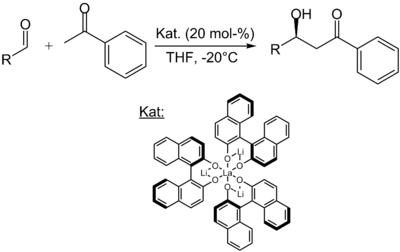- 1,1′-Bi-2-naphthol
-
Strukturformel 
Allgemeines Name 1,1′-Bi-2-naphthol Andere Namen - BINOL
- beta-Binaphthol
- Chirales Binaphthol
- Bis-beta-naphthol
- 2,2′-Dinaphthol
- 1,1′-Bis-2-naphthol
- 2,2′-Dihydroxydinaphthyl
- Bis-beta-naphthol
- 2,2′-Dihydroxybinaphthalin
Summenformel C20H14O2 CAS-Nummer - 602-09-5 (R/S)
- 18531-94-7 (R)-(+)
- 18531-99-2 (S)-(-)
PubChem 11762 Kurzbeschreibung weißes bis beiges Pulver[1]
Eigenschaften Molare Masse 286,32 g·mol−1 Aggregatzustand fest
Schmelzpunkt Löslichkeit gering löslich in Wasser[1]
Sicherheitshinweise GHS-Gefahrstoffkennzeichnung [2] 
Gefahr
H- und P-Sätze H: 301-319 EUH: keine EUH-Sätze P: 301+310-305+351+338 [2] EU-Gefahrstoffkennzeichnung [1] 
Giftig (T) R- und S-Sätze R: 25-36/37/38 S: 26-36/37-45 Soweit möglich und gebräuchlich, werden SI-Einheiten verwendet. Wenn nicht anders vermerkt, gelten die angegebenen Daten bei Standardbedingungen. 1,1′-Bi-2-naphthol (BINOL) ist eine organische Substanz, die meist als Ligand oder Auxiliar zur übergangsmetallkatalysierten asymmetrischen Synthese genutzt wird. BINOL besitzt axiale Chiralität (Atropisomerie). Die Enantiomere können getrennt werden und sind stabil gegen Racemisierung. Der spezifische Drehwert der beiden Enantiomere beträgt ± 33–38° (20 °C, 589 nm) (c=1, THF).[3] BINOL ist ein Vorläufer von BINAP, einem anderen chiralen Katalysator.
Gewinnung und Darstellung
BINOL kann in hoher Ausbeute (90 %) aus 2-Naphthol in Gegenwart eines Kupfer(II)-Katalysators unter Luft- oder Sauerstoffzufuhr synthetisiert werden:[4]
Das Trennen der beiden Enantiomere kann beispielsweise mittels des ebenfalls chiralen (8S, 9R)-(-)-N-Benzylcinchonidiniumchlorids erfolgen.[5] Dabei können durch dessen Zugabe und mehrmaliges Lösen in Ethanol beide Enantiomere in hoher Ausbeute (70–75 %) isoliert werden.
Verwendung
BINOL und seine Derivate werden überwiegend in der asymmetrischen Synthese verwendet.
BINOL dient beispielsweise als Ligand eines Lanthanoids in der Shibasaki-Aldolreaktion, um unmodifizierte Aldehyde enantioselektiv an Ketone zu addieren:[6]
Einzelnachweise
- ↑ a b c d Datenblatt 1,1′-Bi-2-naphthol bei AlfaAesar, abgerufen am 22. Februar 2010 (JavaScript erforderlich)..
- ↑ a b Datenblatt 1,1′-Bi-2-naphthol bei Sigma-Aldrich, abgerufen am 15. März 2011.
- ↑ Datenblatt 1,1′-Bi-2-naphthol bei Acros, abgerufen am 22. Februar 2010..
- ↑ M. Noji, M. Nakajima, K. Koga: "A new catalytic system for aerobic oxidative coupling of 2-naphthol derivatives by the use of CuCl-amine complex: A practical synthesis of binaphthol derivatives", in: Tetrahedron Lett., 1994, 35 (43), S. 7983–7984; doi:10.1016/0040-4039(94)80028-6.
- ↑ Q.-S. Hu, D. Vitharana, L. Pu: "An efficient and practical direct resolution of racemic 1,1′-bi-2-naphthol to both of its pure enantiomers", in: Tetrahedron: Asymmetry, 1995, 6 (9), S. 2123–2126; doi:10.1016/0957-4166(95)00280-3.
- ↑ J. Bülle, A. Hittermann: Das Basiswissen der Organischen Chemie, Thieme, Stuttgart 2000 (Eingeschränkte Vorschau in der Google Buchsuche), S. 308.
Wikimedia Foundation.


